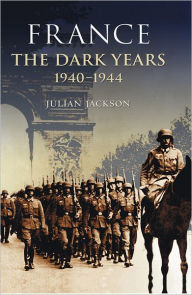A startling and original view of the occupation of the French heartland, based on a new investigation of everyday life under Nazi rule
In France, the German occupation is called simply the "dark years." There were only the "good French" who resisted and the "bad French" who collaborated. Marianne in Chains, a broad and provocative history, uncovers a rather different story, one in which the truth is more complex and humane.
Drawing on previously unseen archives, firsthand interviews, diaries, and eyewitness accounts, Robert Gildea reveals everyday life in the heart of occupied France. He describes the pressing imperatives of work, food, transportation, and family obligations that led to unavoidable compromise and negotiation with the army of occupation. In the process, he sheds light on such subjects as forced labor, the role of the Catholic Church, the "horizontal collaboration" between French women and German soldiers, and, most surprisingly, the ambivalent attitude of ordinary people toward the Resistance.
A great work of reconstruction, Marianne in Chains provides a clear view, unobscured by romance or polemics, of the painful ambiguities of living under tyranny.
Read More
Publishers Weekly
Oxford historian Gildea examines the gamut of French responses to the Nazi occupation of WWII, combining archival research with interviews of some 50 ordinary men and women who survived the war in the Loire Valley. These individuals range over the entire political, religious and social spectrum of France during the occupation. Gildea is especially interested in the creation of postwar narratives about the occupation-attempts to organize memories around such themes as the noble resistance hero confronting the brutal invader or the opposite narrative of pervasive collaboration by the French. Gildea says that after the liberation, right-wing Catholics, Gaullists, the displaced bureaucrats of Vichy, the few surviving Jews and the Communists all competed for control of the occupation's history. In fact, his research shows, events during the war were not as clear-cut as the postliberation myths suggest. Instead, rather than being all heroes or all collaborators, the French had to improvise, playing an intricate (and increasingly dangerous) double game of impressing the Germans as cooperative while carving out as much autonomy as possible as conditions changed. Overall, Gildea sees the French as creative and flexible, with interest groups such as industrial workers or farmers devising strategies and building networks for self-protection. The horizons of people's loyalties shrank from the nation as a whole to the factory, the village or the family. The strength of this book lies in the author's appreciation of the complexity of people's behavior under pressure. Delving behind the postwar stereotypes, Gildea (France Since 1945) reveals the myriad paths ordinary French citizens took to survive the occupation. 16 pages of photos, 5 maps not seen by PW. (Aug. 4) Copyright 2003 Reed Business Information.
Foreign Affairs
This distinguished British historian of France has written a very fine history of "everyday life in the French heartland" (the Loire Valley) during the German occupation. There have been previous studies of French attitudes and behavior from 1940 to 1945, and Gildea's conclusions do not differ much: rejecting the myths of both a heroically resistant France and a cowardly, collaborationist France and pointing out the various kinds of accommodation the French population practiced under German and Vichy rule. What is new and important is Gildea's care in documenting, through interviews and difficult-to-obtain archives, exactly how the French lived, what strategies they used, and how they faced hardships and challenges during "the dark years" — a term Gildea finds misleading, for they were not dark for everyone.What emerges from this fascinating mass of detail is the complexity and diversity of the French experience. A country addicted to centralization found itself cut in two by the "demarcation line," and Vichy's authority was never decisive in the occupied half. As a result, local "notables" (especially mayors, but also landowners, businesspeople, and religious leaders) acted as crucial intermediaries between officials, German or Vichyite, and the population. Gildea thoroughly treats the main issues: the problem of food, terrorism, the fate of the Jews, forced-labor conscription, conflicts between resisters and ordinary citizens afraid of reprisals, the turbulence of the liberation, the era of disappointment that followed it, and the bewildering clashes of memories that persist. His most interesting observation, however, is of how the occupation led not only to violence and hatredbetween the French and the Germans, but also to a complex mutual experiment in learning to live together — perhaps a crucial factor in postwar reconciliation and, eventually, European integration.
Library Journal
This extremely well-researched, highly readable, revisionist account strives to break free from simplistic and one-dimensional characterizations of French life under Nazi rule. Employing previously unused archival records, interviews, diaries, and eyewitness accounts, Gildea (European history, Oxford), a follower of acclaimed social historian Richard Cobb, challenges the common view of the occupation as characterized by "cold, hunger, the absence of freedom, and, above all, fear." Intending to find out what life was really like at the time, he focuses on ordinary folk in the Loire valley, a region that he sees as typical of occupied France. He shows that instead of being traumatized, the French formed new networks within their communities and negotiated new relationships with their overlords. He finds numerous instances of cooperation between French and Germans, "cohabitative" opportunities arrived at for both pleasure and profit. He painstakingly aims to show that the occupation was experienced very differently on the national and local levels, and implicitly chastises those interest groups who propagate and defend less nuanced views. An important book for interested lay readers and specialists in the field.-Marie Marmo Mullaney, Caldwell Coll., NJ Copyright 2003 Reed Business Information.
From the Publisher
Gildea has done a great service...A considerable achievement.” —The New York Times“[A] carefully researched and richly nuanced study.” —The Boston Globe
“Subtle and humane.” —The New Yorker
“A searching inquiry...Provocative—and timely.” —Kirkus Reviews (starred)
“Stunning...In his nuanced and intricate work of historical reconstruction Gildea has grappled heroically with the ambiguity at the heart of history and in the heart of man.” —The Atlantic Monthly
Read More
















